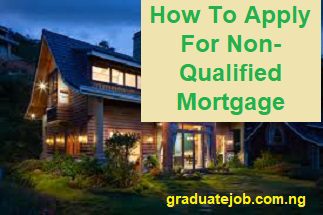Do you have hope to buy a home but worry that you can’t qualify for the traditional mortgage, then apply for a non-qualified mortgage.
After the recession in 2008, traditional mortgage lenders tightened the lending criteria. In many ways, it is good for borrowers as unethical lenders that won’t pressure them into taking mortgages they can’t afford.
This means that anyone without traditional employment income and pay stubs to prove how difficult to be eligible for the mortgage.
Non-qualified mortgages solve this problem, offering freelancers, small business owners, and individuals with low credit scores to buy a home.
Keep reading to know what a non-QM loan is all about and how to apply for a non-qualified mortgage.
READ MORE: How to Apply for a Non-Qualified Mortgage
What Is a Non-Qualified Mortgage?
The non-qualified mortgage is also called a non-QM loan. This is a kind of mortgage product that doesn’t require to meet the Consumer Financial Bureau’s agency-standard documentation requirements.
Also, the meaning varies, these mortgages can take forms like bank statement mortgages or mortgages for self-employed individuals to make it easy for the wide swath of the population to qualify.
Non-QM loans:
- It can exceed CFPB’s current price-based thresholds.
- Also, be flexible with the loan eligibility requirements.
- Accept the low credit scores.
- You can approve the high debt-to-income (DTI) ratios.
- Accept diverse forms of proof of income like the bank statements
- It can exceed 30-year terms.
- Can have negative amortization.
- It offers interest only on payments.
The non-QM mortgage is not backed by the government agencies like FHA, VA, Fannie Mae, and Freddie Mac.
Differences Between Qualified and Non-Qualified Mortgages
The difference between qualified and non-qualified mortgages comes down to the qualification requirement and backing.
One or more government agencies back a qualified mortgage: they must meet the standards set out by the Consumer Financial Protection Bureau.
Due to the strict qualification requirements, there are various individuals without standard employment income or the low credit score low can have difficulty buying a home.
The qualified loans, up to 43% of the borrower’s income can go towards the loan. For non-QM loans, the debt-to-income ratio can be high. Moreover, qualified loans can have limits in upfront costs and fees and can’t extend beyond 30 years.
The non-QM loan can have more lenient standards that include a high debt-to-income ratio, longer loan terms, or unusual income resources.
Some individuals can benefit from the non-qualified mortgage include:
- Freelancers
- Business owners
- Real-estate investors
- Gig workers
- Retirees
- Individuals with high debt
- Foreign nationals
- People with high assets and low income
- Those with a low credit score.
How To Get the Non-Qualified Mortgage
Maybe you are looking for a non-QM lender? You don’t need to search much; Angel Oak Home Loans is a full service that gives many unqualified mortgage products to homebuyers that will not qualify for a conventional mortgage.
Moreover, you can get the following non-QM loans through Angel Oak Home loans:
- Banks statement loan
- Asset qualifier home loan
- Investor cash flow home loan
- Jumbo loan
- 1099 Income Loan
- Foreign national program
- ITIN mortgage.
Then submit the simple online form to get the non-QM mortgage quote or find the loan officer that will guide you through the application process.
READ MORE: What Is a Non-QM Mortgage and How to Get One?
How Do I Apply for The Non-Qualified Mortgage?
When you are ready to apply for the non-QM loan, then follow these steps on how to apply for a non-qualified mortgage:
1. Determine Your Eligibility
When non-QM loans are more lenient requirements, eligibility requirements can vary by lender. Prepare documents, that include evidence of income like bank statements, pay stubs or tax returns and business documents.
You’ll also need to bring basic personal information like ID and social security number.
Moreover, lenders will look for your financial stability and reliability. It can use income proof like the oat stud or bank statements to verify this, along with credit scores, additional income streams and savings accounts, investment accounts or assets.
2. Research Non-Qualified Mortgage Lenders
Also, you can do research for the non-QM lender online or locally. Make sure you read reviews and read the fine print before you decide on the lender.
Moreover, to get started, find the best non-QM lenders or mortgage lenders that don’t require tax returns.
3. Gather Required Documents
Be sure to gather the necessary documents that you may need ahead of time. It includes:
- Verification of income
- Pay stubs
- Income tax returns
- Bank accounts statements
- Business documents
- Valid government-issued ID
- Verification of current residence like the utility bill.
However, with this documentation, most lenders will require you to fill out a simple application that asks about income, debt and other financial obligations.
4. Complete Your Application
To complete the application, you will need to follow your specific lender’s instructions for submitting and completing the application.
Moreover, you need to check the information requested to ensure you’ve submitted everything they require. Also, double-check the terms mentioned in the mortgage application.
5. After The Loan Is Approved
Once you’ve been accepted for the non-QM loan, your ongoing obligations will involve making payments on time. It’s also important to monitor your credit score and manage debt to ensure that your finances remain stable.
Additionally, before you take out the loan, it is essential not to accept a large mortgage that you can comfortably pay off every month to reduce the risk of default.
READ MORE: 5 Things You Should Know About Non-Qualified Mortgages
Conclusion
A non-qualified mortgage will help unconventional buyers to get loan approval. Also, even a non-qualified mortgage is not without requirements: you’ll still need to demonstrate an ability to repay your loan and once sign your loan documents.






